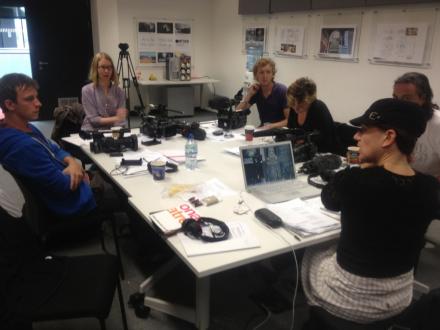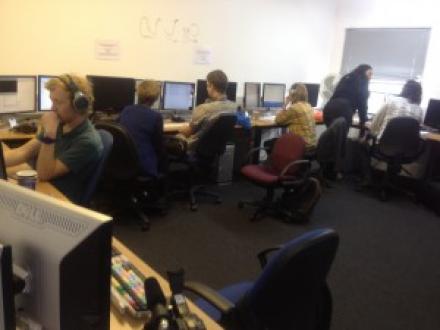The Media Development Authority has recently re-started a Talent Assistance Scheme where media practitioners can apply for partial funding to attend media courses. Where the course is not taught in Singapore, funding can be sought for overseas courses conducted up to a limit of SGD15000/person/year. I applied for and received funding to attend the Observational Filming Short Course (5 days) at the National Film & TV School, UK (NFTS), I felt I needed a refresher for the Cinema Verite or fly-on-the-wall style of shooting that is the backbone of many indie documentaries. I found the quality of teaching and professionalism at NFTS very high. My course itself, conducted about 1-2 times a year and taught by Zillah Bowes is highly recommended.
Here is some information about the NFTS short courses offered. The wonderful thing is the range. There are industry focused courses like courses on focus pulling, there are also DIY shoot-from-the-hip kind of courses like “filmmaking on a microbudget”. The Australian Film, Television and Radio School, modeled on the NFTS also offers a similar range of short courses which are just as rigourous. Sydney is of course nearer to Singapore and less of trial to get to. The Singapore equivalent is the Singapore Media Academy. Some of the courses here are well conducted but course selection is less deep and wide-ranging.
I am reproducing my MDA Trip Report. Its detailed and let’s on what the syllabus covers.
“This course was very useful for those who are interested in the telling stories using the “verite”, “observational” or “fly on the wall” style of documentary filmmaking. It is the kind of documentary where the actions and speech of the protagonists is a main feature of the documentary, a style which relies less on voiceovers to make dramatic points.
The five-day course focused on:
-How to construct a scene, in terms of what shots to take, what audio to record, what questions to ask during action.
-How to mic up the speaker
-How the camera should follow dialogue in a scene, where to place the camera
-How to pan correctly
-How to move the camera seamlessly so the edit is seamless
-How to shoot for editing
Every day we had to shoot exercises that built up towards the final project. The exercises included: how to shoot “continuous action” which is something repetitive and unchanging, say a chef kneading dough, and how to shoot an unpredictable exchange between two people. The final exercise was shooting a scene with people interacting, set in a locale of our choosing.
What I learnt
Watching our exercises which we also had to edit ourselves (a good pedagogical tool to teach shooting I found! Nothing like having to edit around one’s mistakes), I felt that most of my classmates including myself don’t hold shots long enough for dramatic effect, we usually feel impatient and zoom in or cut too early. Shooting time and watching time feel different, so most people need to make a deliberate and counter-intuitive act to hold a shot longer than we normally would.
Also, when following someone, it is important to let them leave the shot, so that that can be a cut point. This is obvious, but it is easily forgotten. In a conversation, we need to shoot cut away reactions of people, so that there are edit points for dialogue. The trick is to let the audio recording continue even while we are adjusting a shot so that the audio conversation is still usable.
Other stuff covered
1 Panning/Tilting: start with the end position so we don’t have to contort ourselves
2 How to balance the camera’s weight: keep knees bent, strengthen core through yoga (!)
3 How to walk and shoot: keeping footsteps in phase with protagonists
4 Focus on faces, less on actions.
5 Heavier cameras are more stable.
6 The need to familiarise ourselves with the camera so that we know which direction to turn the rings if we want to close the aperture/zoom in or out, these should be second nature and mastered.
One of the strong points about this course is that it historicises this style of shooting. We were shown examples from the pioneers, Maysles like Don’t Look Now, Primary and Salesmen. Kim Longinotto’s Sisters-in-Law and Hold Me Tight, Let Me Go were used as current gold standard examples.
News cameraperson or cameraperson or directors wanting to shoot more verite-styled documentaries will find this course useful because of the emphasis on story-telling through the drama within the scenes. The cameraperson has to pay particular attention to what is said and direct the camera accordingly. Also it focuses on the shots needed to set up a scene.
The quality of the NFTS’ teaching is very high. Class size was small, six. The tutors were very experienced and thought carefully how to structure the course for it to make sense to us. Equipment, facilities as well as the library are also very comprehensive. At GBP700, it is very good value. Though it touches on some basics, there is enough for an experience cameraperson/director to take something away from the course too.
A demonstration on how to climb stairs smoothly while shooting

Using the eyepiece to steady the camera while shooting handheld

Critiquing each other’s work after shooting exercise






